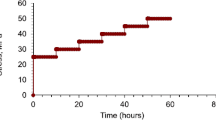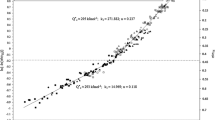Abstract
A new accelerated technique, called the stepped isostress method (SSM), is presented that allows accelerated testing of materials to determine their creep response, and in particular, their creep-rupture behaviour. The approach in SSM testing is similar to the more familiar stepped isothermal method (SIM) but the acceleration is now obtained by increasing the stress in steps rather than stepping the temperature. Additional stress provides energy to the system in an analogue of the effect of heat in SIM. This method relies on the time–stress superposition concept. Various theories, assumptions and the different steps of the method are described in detail. This method is advantageous when compared with SIM because there is no need to use elevated temperatures, which may affect the chemical properties of the tested materials. The applicability of this method is investigated. The paper presents testing on Kevlar 49 yarns using SSM. The resulting creep curves and rupture times are compared with those obtained from SIM and conventional creep testing carried out in the past. The results show good correlation between the three test methods. The ability to carry out reliable creep tests in a reasonable time at low stress levels allows a designer to have much more confidence in the data for creep-rupture behaviour for fibres and allows confident prediction of structural lifetimes.

















Similar content being viewed by others
References
Guimaraes GB (1988) Parallel-lay aramid ropes for use in structural engineering. University of London, London
Burgoyne, CJ (1992) In: Doran DK (ed) Construction materials reference book, Butterworths, Oxford
Gerritse A, Taerwe L (1999) In: Proceedings of the 4th international symposium on fiber reinforced polymer reinforcement for reinforced concrete structures, ACI SP-188
Giannopoulos IP (2009) Creep and creep-rupture behaviour of aramid fibres. University of Cambridge, Cambridge
Giannopoulos IP, Burgoyne CJ (2009) Struct Build 162(4):221
Chiao TT, Wells JE, Moore RL, Hamstad MA (1974) In: 3rd conference on composite materials: testing and design
Phoenix SL, Wu EM (1983) In: Hashin Z, Herakovich CT (eds) Mechanics of composites materials: recent advances, Pergamon Press, New York
Glaser RE, Moore RL, Chiao TT (1984) Compos Technol Rev 6(1):26
Wagner HD, Schwartz P, Phoenix SL (1986) J Mater Sci 21:1868. doi:https://doi.org/10.1007/BF00547921
Wu HF, Phoenix SL, Schwartz P (1988) J Mater Sci 23:1851. doi:https://doi.org/10.1007/BF01115731
Phoenix SL, Grimes-Ledesma L, Thesken JC, Murthy PLN (2006) In: Proceedings of the american society for composites, 21st annual technical conference, 17–20 Sep 2006, The University of Michigan-Dearborn, Dearborn
Chambers JJ (1986) Parallel-lay aramid ropes for use as tendons in prestressing concrete. University of London, London
Guimaraes GB, Burgoyne CJ (1992) J Mater Sci 27:2473. doi:https://doi.org/10.1007/BF0110506
Yamaguchi T, Kato Y, Nishimura T, Uomoto T (1997) In: Proceedings of the 3rd international symposium on non-metallic reinforcement for concrete structures (FRPRCS-3), vol 2, Sapporo
Ando N, Matsukawa T, Hattori M, Mashima M (1997) In: Proceedings of the 3rd international symposium on non-metallic reinforcement for concrete structures (FRPRCS-3), vol 2, Sapporo
Ward IM, Sweeney J (2004) An introduction to the mechanical properties of solid polymers. Wiley, London
Thornton JS, Paulson JN, Sandri D (1998) In: Sixth international conference on geosynthetics, Atlanta
Alwis KGNC, Burgoyne CJ (2008) J Mater Sci 43(14):4789. doi:https://doi.org/10.1007/s10853-008-2676-0
Lai J, Bakker A (1995) Polymer 36(1):93
Hadid M, Rechak S, Tati A (2004) Mater Sci Eng 385:54
Jazouli S, Luo W, Bremand F, Vu-Khanha T (2006) Key Eng Mater 340–341:1091
Ma CCM, Tai NH, Wu SH, Lin SH, Wu JF, Lin JM (1997) Composites B 28B:407
Luo W, Wang C (2007) Key Eng Mater 340–341:1091
Farquhar D, Mutrelle FM, Phoenix SL, Smith RL (1989) J Mater Sci 24:2151. doi:https://doi.org/10.1007/BF02385436
Ericksen RH (1976) Composites 7:189
Ericksen RH (1985) Polymer 26:733
Alwis KGNC (2003) Accelerated testing for long-term stress-rupture behaviour of aramid fibres. University of Cambridge, Cambridge
Yang HH (1993) Kevlar aramid fiber. Wiley, Chichester
Du Pont EI (1991) Data manual for fibre optics and other cables. EI Du Pont de Nemours and Co (Inc.), Wilmington
Giannopoulos IP, Burgoyne CJ (2009) In: 16th Concrete Conference, Paphos, 21–23 Oct 2009
Giannopoulos IP, Burgoyne CJ (2008) In: 5th conference on advanced composite materials in bridges and structures (ACMBS-V) Paper 79, Winnipeg
Truhlar DG, Garrett BC, Klippenstein SJ (1996) J Phys Chem 100(31):12771
Slutsker AI (1989) Makromol Chem 27:207
Bosman M, Van der Zwaag S, Schenkels FAM (1995) J Mater Sci Lett 14:1440
Author information
Authors and Affiliations
Corresponding author
Rights and permissions
About this article
Cite this article
Giannopoulos, I.P., Burgoyne, C.J. Prediction of the long-term behaviour of high modulus fibres using the stepped isostress method (SSM). J Mater Sci 46, 7660–7671 (2011). https://doi.org/10.1007/s10853-011-5743-x
Received:
Accepted:
Published:
Issue Date:
DOI: https://doi.org/10.1007/s10853-011-5743-x




